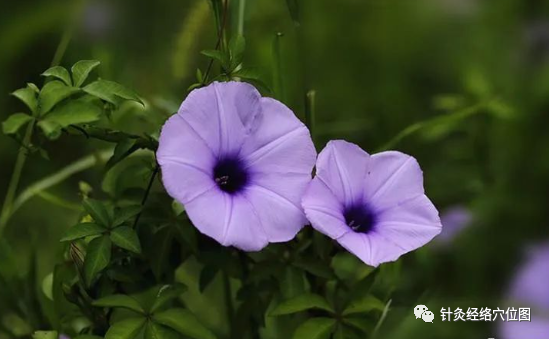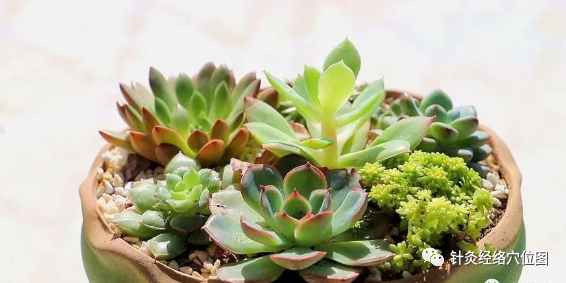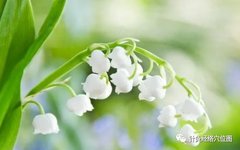What are Luo points?
In simple terms: Luo means to connect and distribute. Each of the fifteen Luo vessels has a corresponding acupoint, known as a Luo point.
Luo points have five unique functions.
1. All twelve meridian Luo points have the function of connecting, regulating, and balancing the Qi and blood of the left and right sides of the body. Because Luo points connect, regulate, and balance the Qi and blood of the left and right sides of the body, any pathological state of imbalance or disharmony that occurs between the left and right sides can be treated using the corresponding Luo points.

Example 1: Last year in Sichuan, I encountered a patient whose upper tissue at the Lie Que (Luo Point) on the left hand was swollen, reaching the size of a thumb, making it impossible to grip and weak for about six months. The patient had previously undergone acupuncture and point injection treatments, as well as taken Western medicine, which were effective at the time but the condition recurred. Upon examination, I immediately recognized it as a Lie Que issue, as the Lie Que point was unable to properly drain the liquid from the lung meridian, causing blockage. I treated it by inserting a needle into the Lie Que point and leaving it for twenty minutes. After the treatment, the patient reported that the pain in the wrist had mostly disappeared, and the swelling significantly reduced. During the follow-up the next day, the swelling had completely subsided, and there was no pain. A second treatment was given to consolidate the effect.

Example 2: Many people have experienced nasal congestion and runny nose, often with one side blocked. In this case, the acupuncture points also differ by side; if the left side has a runny nose, needle the left side, and if the right side has a runny nose, needle the right side. A simple upward insertion at the Lie Que point can cure it.
Example 3: For patients with hemiplegia or unilateral facial paralysis due to stroke, selecting Luo points for treatment is essential, such as Wai Guan (Outer Pass), Lie Que, and Tong Li (Pass Through). The reason for choosing these points is their role in balancing the functions of the left and right sides of the body. As mentioned in my previous articles, for facial paralysis where the tip of the tongue deviates to one side, my principle is to needle the side where the tongue deviates. Using only Tong Li and Xie Men (Aperture Gate), significant effects can generally be seen after one or two treatments, as these points have the function of draining excess Yin from the heart, allowing Yang Qi to return. The heart opens to the tongue, hence the selection of heart and pericardium meridian points.
Example 4: Migraines can often be treated using the corresponding Luo points of the relevant meridians. For example, if the headache is due to spleen dysfunction leading to dampness, the Gong Sun (Grandfather Sun) point on the painful side can be selected. For Shao Yang headaches, the Guang Ming (Bright Light) point can be chosen.
Example 5: For unilateral leg weakness and reluctance to move, the Fei Yang (Flying Yang) point of the bladder meridian can be selected to strengthen local Yang Qi.
Example 6: For unilateral trigeminal neuralgia, the same side Feng Long (Abundant Bulge) point can be selected to reduce dampness and phlegm and alleviate pain.
2. All Luo points have the function of regulating and balancing the corresponding interior and exterior meridian Qi and blood.
Example 1: The lung and large intestine are interior-exterior paired organs. If the states of the lung and large intestine systems are relatively unbalanced, the corresponding Luo points can be used for treatment. For instance, if there is lung heat and dryness with large intestine deficiency and cold, clinical manifestations may include dry, hot, and itchy skin on the upper body, while the stool may be loose or diarrhea. This indicates that the functions of the lung and large intestine are not on the same level, and there is poor communication between the interior and exterior. The Luo point of the large intestine, Pian Li (Pian Li), is the first choice for treatment. The method is to needle from the Pian Li point towards the lung meridian and leave the needle for thirty minutes to adjust the imbalance between the lung and large intestine, allowing the Yin of the large intestine to communicate with the lung meridian, thus preventing the Yin fluid of the lung from becoming too dry.
Similarly, if symptoms of lung cold and large intestine heat appear, simply needling the Lie Que point towards the large intestine meridian can achieve the desired relief of symptoms.
Example 2: If a person has kidney cold and bladder heat, this indicates disharmony between the kidney and bladder meridians. By needling the Luo point Da Zhong (Great Bell) towards the bladder meridian, the cold water of the kidney can be directed towards the bladder meridian, resolving the issue without complicating a simple problem. This is also a method of acupuncture guidance. For those unfamiliar with acupuncture, the Da Xun (Great Circulation) finger moxibustion guidance technique can be used, which is painless and harmonizes the mind, body, and spirit.
Conversely, if there is kidney heat and bladder cold, needling the Fei Yang point towards the kidney meridian can direct the bladder’s cold water towards the kidney, resolving the imbalance between the two organs.
3. All Luo points have the function of regulating and balancing the Qi and blood of the corresponding named meridians.
Luo points, as the name suggests, are characterized by their ability to connect the Qi and blood of various meridians, playing a role in balancing and regulating excess and deficiency. Many people have a good understanding of how Luo points can communicate between the interior and exterior, but fewer recognize that Luo points can also connect and regulate the balance of the Qi and blood of the corresponding named meridians.

Among the twelve primary meridians, there are two that share the same name. The reason for this is that their Qi and blood characteristics are similar. Qi and blood substances with similar characteristics can communicate, circulate, and exchange with each other, as they exist within the same three-part, nine-phase level of heaven, earth, and humanity. Therefore, they can communicate well, and the main acupoints that facilitate this communication are the Luo points.
Example 1: Clinically, patients often present with Yang deficiency of the bladder and coldness, along with abdominal heat and constipation, or frequent urination. Such patients are not uncommon, and the pathogenic mechanism often involves poor communication between the Yang bladder meridian and the Yang small intestine meridian. Due to the inability of the small intestine meridian’s Luo point Zhi Zheng (Branching Correct) to properly distribute its heat Qi and blood to the bladder meridian, the bladder receives insufficient energy, leading to inadequate Qi transformation and excess cold dampness, resulting in frequent urination and hard stools. The treatment is simply to needle the Zhi Zheng point to resolve the above issues.
Example 2: Clinically, it is also common to encounter patients with insufficient heart Yin and concurrent kidney Qi deficiency, presenting as easy to develop heat, dry mouth, and cold intolerance. This indicates a shared disease between the Shao Yin heart meridian and the Shao Yin kidney meridian (same-named meridian disease), where the kidney meridian’s Qi cannot effectively ascend and communicate with the heart meridian. Treatment usually requires only the Luo point Da Zhong to be needled to promote its Qi to ascend and communicate with the heart meridian, effectively resolving the above issues without needing to find other points.
4. Specific Luo points can quickly adjust and balance the Qi and blood that can flow through the meridians.
The specific Luo points referred to here are:
Lie Que point, which can connect the Ren meridian and the spleen;
Tong Li point, which can connect the uterus and internal organs;
Nei Guan point, which can connect the Yin Wei meridian;
Wai Guan point, which can connect the Yang Wei meridian;
One of the functions of the Lie Que point is to drain the liquid from the lung meridian. It not only distributes the liquid from the lung meridian to the large intestine meridian but also directs the liquid from the lung meridian towards the Ren meridian and spleen meridian.
The Ren meridian governs all Yin in the body. When symptoms of Yin deficiency in the Ren meridian appear, such as delayed or scant menstrual flow, the Lie Que point can be used for treatment. I once treated a patient who experienced severe bleeding after a miscarriage and had secondary infertility for four and a half years. The main point used was Lie Que, where I injected a small amount of saline to replenish the Yin of the Ren meridian and guide the liquid from the lung meridian down to the Ren meridian. This woman became pregnant seventeen days after treatment.
The Lie Que point has the function of regulating the Yin of the Ren meridian. Whenever I encounter patients with excessive leukorrhea, I use finger moxibustion to guide the Lie Que point in reverse, achieving good therapeutic effects within two to three days, rapidly reducing the leukorrhea to normal levels.
One of the functions of the Tong Li point is to drain the Yin liquid of the heart meridian. It not only directs the Yin liquid of the heart meridian towards the small intestine but also guides the Yin liquid and heat energy towards the uterus and kidneys. Clinically, if I encounter patients with insufficient heart Yang, excess heart Yin, and insufficient menstrual flow, I usually do not differentiate but directly needle the Tong Li point to direct the excess Yin liquid of the heart meridian towards the uterus to achieve the desired effect, often within a few treatments. Another case I mentioned in a previous article involved a patient I encountered in Guizhou, who had heat in the upper body and cold in the lower body, indicating a clear case of heart-kidney disharmony, as the heart Yang could not descend to the kidneys, resulting in coldness and fear of cold in the lower body, while excess heart fire caused heat intolerance in the upper body. Blood is governed by the heart, which belongs to fire, and blood has the function of spreading heat energy. The Huo Gong Tui Na (Fire Function Massage Guidance) indicates that the Tong Li point is the channel through which heart heat is transmitted down to the kidney meridian. By opening this channel, the heart’s heat energy can be effectively transmitted to the kidneys, balancing the energy distribution between the heart and kidneys. By grasping the essence of this condition and applying the appropriate treatment, this long-standing issue (over ten years) was resolved in one week.
One of the specific functions of the Nei Guan point is to connect with the Yin Wei meridian, which serves to regulate internal Yin liquid, preventing it from escaping. It directs the excess Yin liquid of the body towards the Yin Wei meridian, which then distributes the excess Yin liquid to various parts of the body, maintaining a normal distribution of internal and external Yin liquid.
If there is excess Yin liquid in the exterior, the Nei Guan point can be needled with a lifting and thrusting technique to direct the excess Yin liquid inward; if heart disease occurs due to insufficient heart Yang, needling the Nei Guan point can yield good therapeutic effects.
If there is excess internal Yin liquid and insufficient external Yin liquid, needling the Nei Guan point with a draining technique can direct the excess internal Yin liquid outward;
If there is no absolute deficiency of internal Yin liquid, but the balance is disrupted, and a certain area is relatively deficient, strong stimulation at the Nei Guan point can improve the state of imbalance of internal Yin liquid;
If there is no absolute deficiency of external Yin liquid, but the balance is disrupted, and a certain area is relatively deficient, adjustments can be made at the Nei Guan point based on where the external body is deficient and where it is excessive.
One of the specific functions of the Wai Guan point is to connect with the Yang Wei meridian, which serves to regulate external Yang Qi, preventing it from entering the interior. It directs the excess Yang Qi of the body towards the Yang Wei meridian, which then distributes the excess Yang Qi to various parts of the body, maintaining a normal distribution of external and internal Yang Qi.

5. All Luo points have the function of regulating and balancing the Qi and blood of the various parts of the meridian.
The Wan Wu Therapy indicates that Luo points have another important characteristic: they all have the function of regulating and balancing the Qi and blood of the various parts of the meridian. Luo points can not only connect the interior and exterior meridians but also connect the upper and lower parts of the same meridian’s Qi and blood. They serve as a boundary line for the Qi and blood of the upper and lower parts of the meridian. If there is a significant asymmetry or imbalance in the Qi and blood between the upper and lower parts of the meridian, the Luo point of that meridian is the first choice for treatment.
If the Qi and blood of the lower meridian is excessive while the upper meridian is deficient, needle from the Luo point upwards;
If the Qi and blood of the upper meridian is excessive while the lower meridian is deficient, needle from the Luo point downwards.
Give a thumbs up to support health together! Click the “business card” below to follow us
Click the “business card” below to follow us
Light it up so more people can see👇

